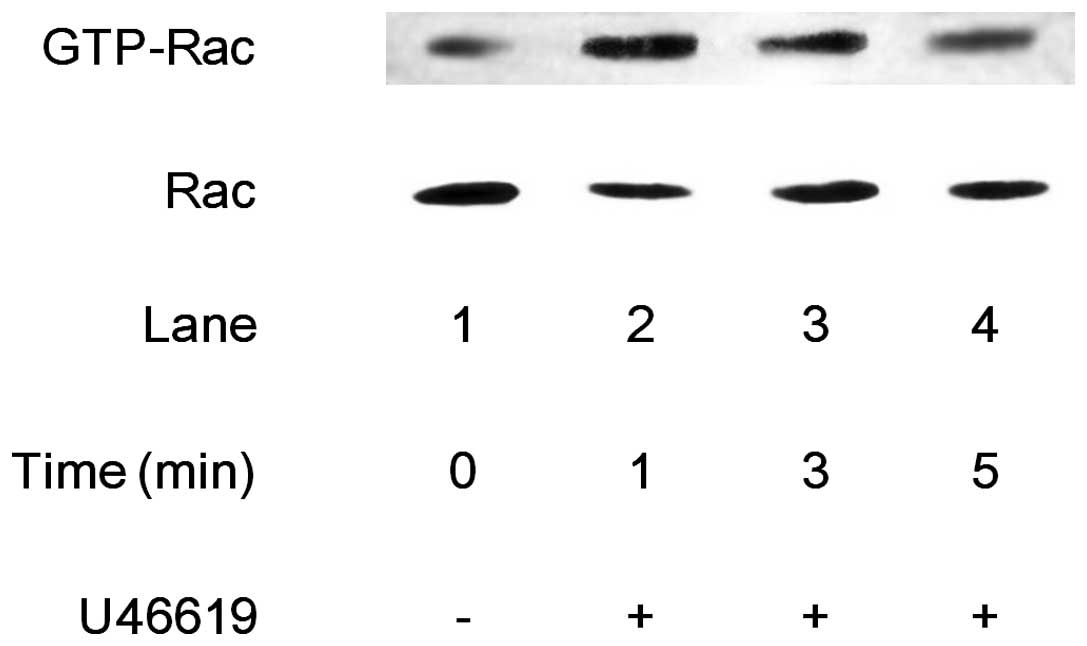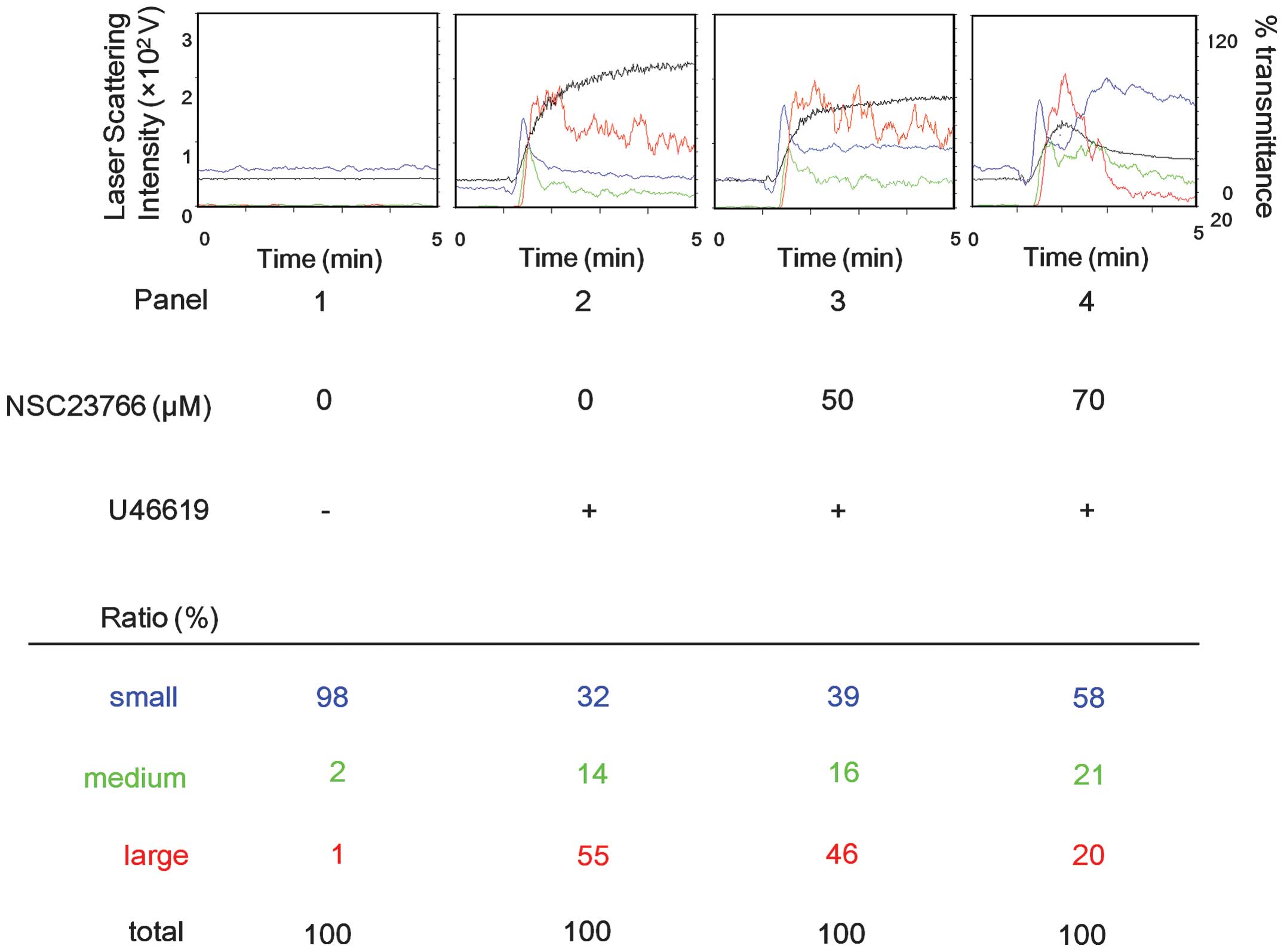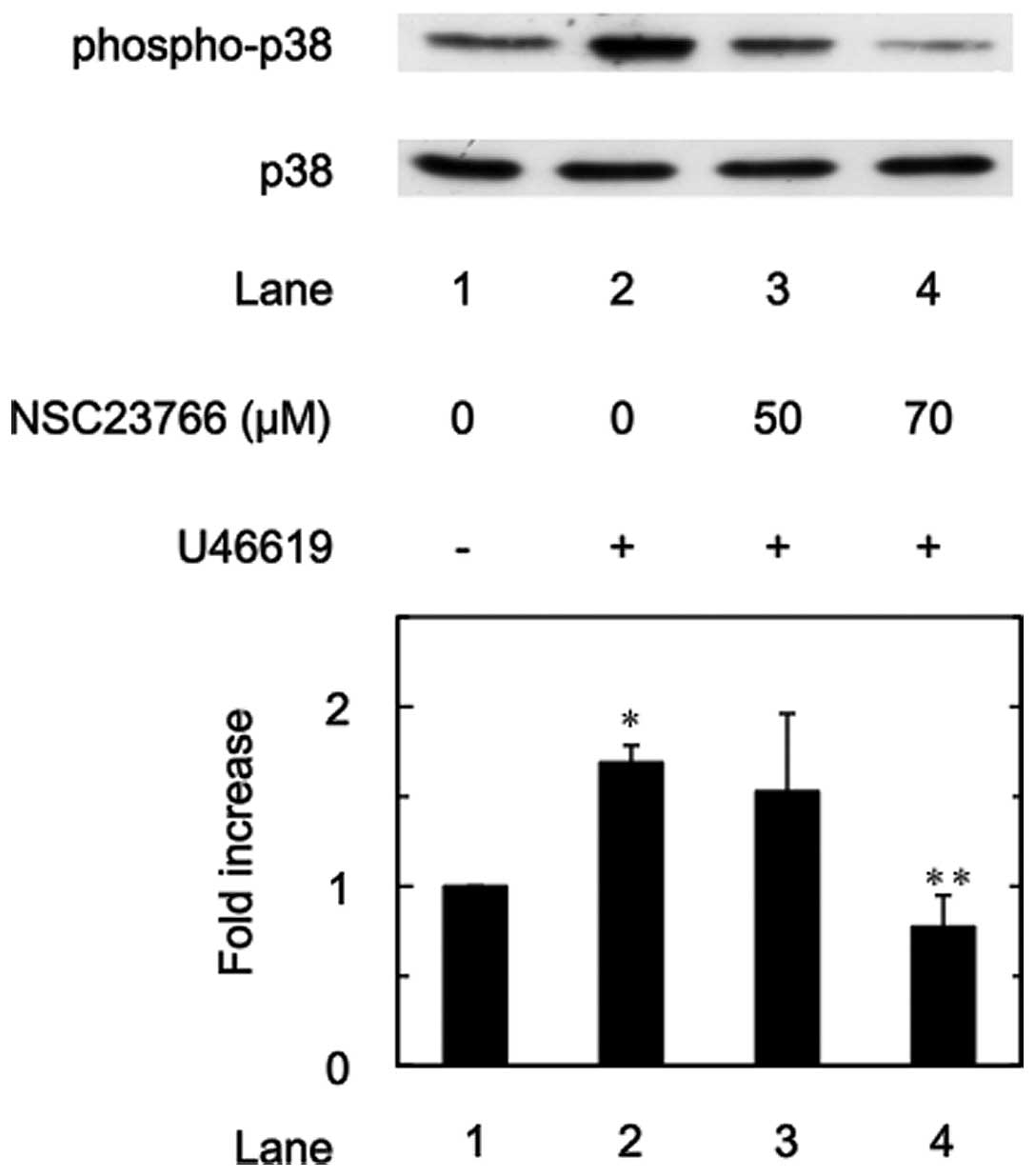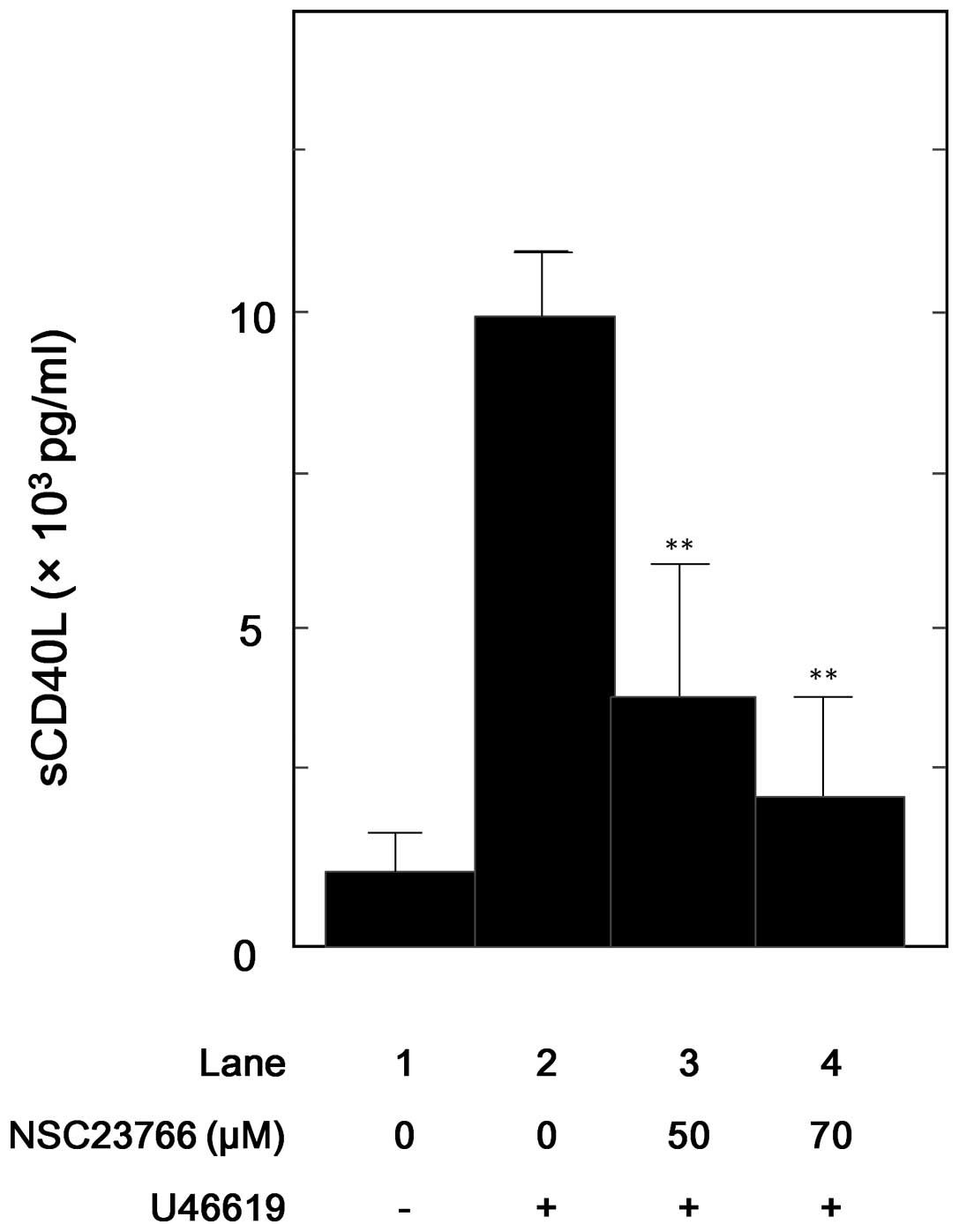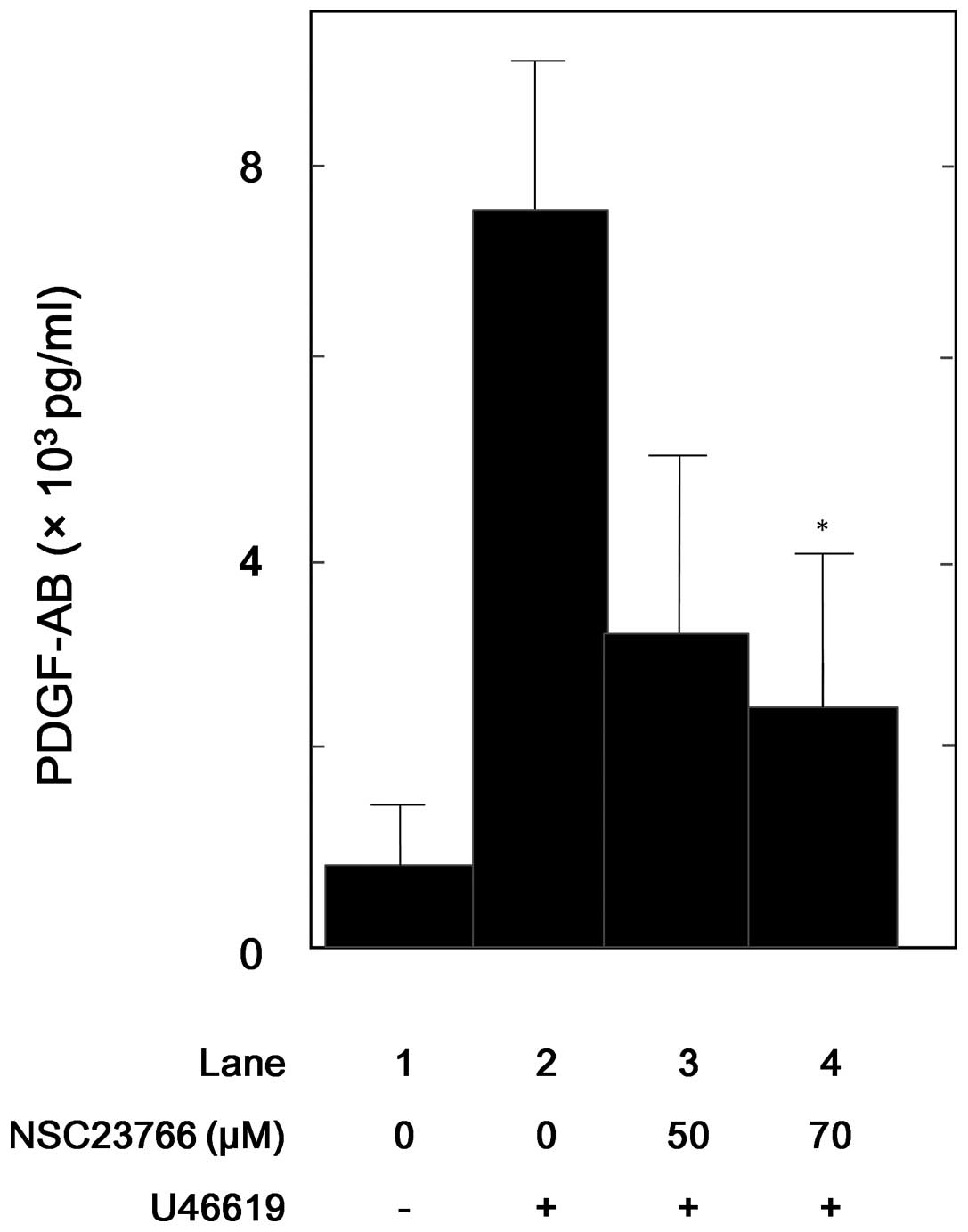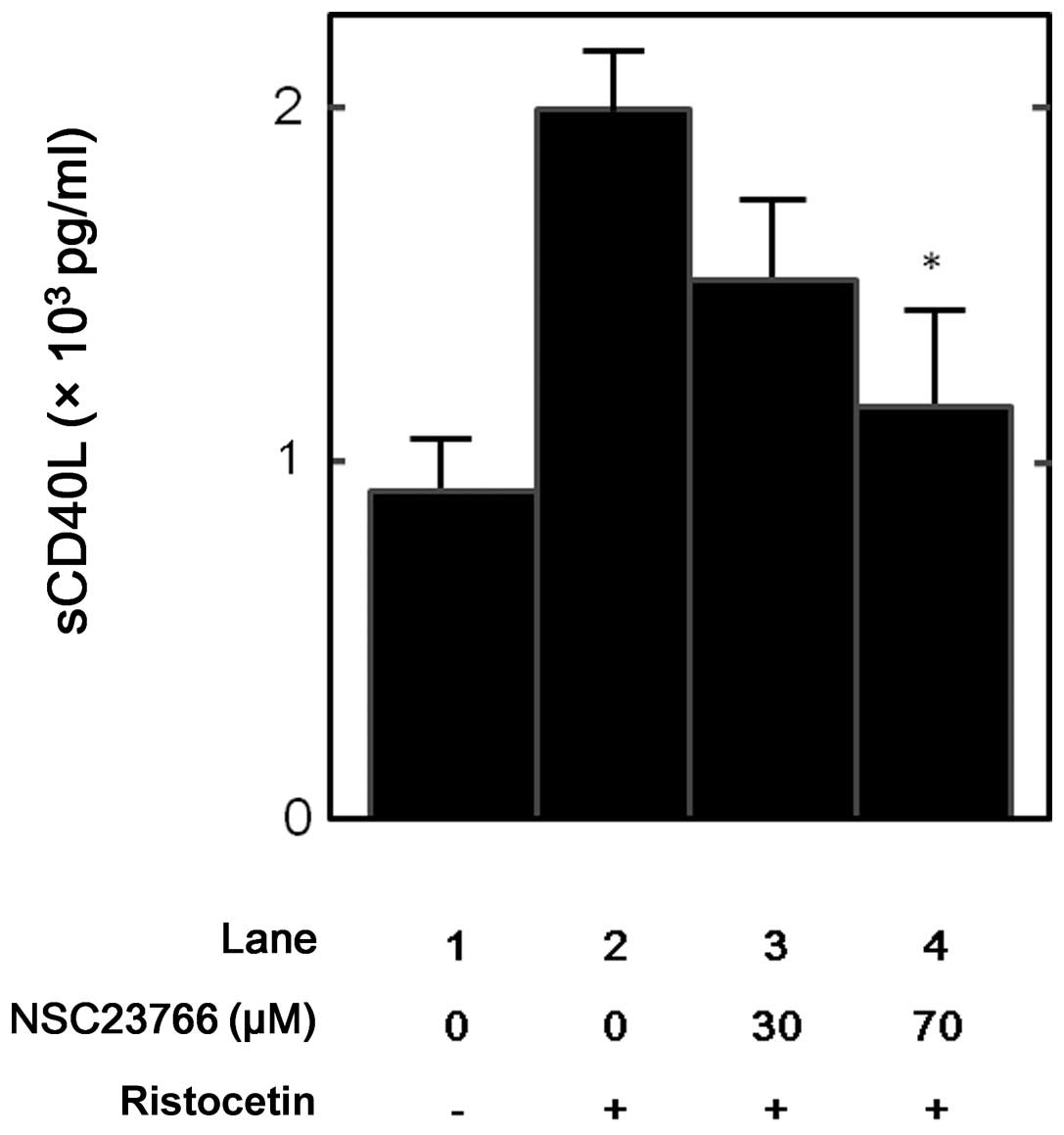Involvement of Rac in thromboxane A2‑induced human platelet activation: Regulation of sCD40 ligand release and PDGF‑AB secretion
- Authors:
- Published online on: April 15, 2014 https://doi.org/10.3892/mmr.2014.2143
- Pages: 107-112
Abstract
Introduction
Human platelets are crucial in the primary hemostasis and repair of the injured endothelium (1,2). Additionally, platelets also act in the development of vascular events. Platelets may cause blood vessel occlusion by forming a thrombus, leading to myocardial infarction and brain strokes. Platelet activation and aggregation represent the first step in thrombus formation at an injured vascular site. The initial adhesion of flowing platelets to the injured vessel wall is mediated by the interaction of the glycoprotein Ib/IX/V complex with von Willebrand factor (2). Following the adhesion of the platelets, the repair of the injured endothelium is processed by autocrine and paracrine mediators, including ADP and thromboxane A2. These autacoids enhance and sustain the initial platelet response. Finally, glycoprotein IIb/IIIa (αIIbβ3) is activated by platelet activators, and a hemostatic plug is formed. Thrombus formation is associated with the release of granule contents, including platelet-derived growth factor (PDGF)-AB and serotonin, and the release of inflammatory substances, including soluble CD40 ligand (sCD40L). These secreted and generated mediators trigger a positive feedback mechanism that potentiates the platelet activation (3,4).
It has been established that human platelets mainly contain a synthase (cyclooxygenase) that generates thromboxane A2 in the metabolism of arachidonic acid (5). Thromboxane A2, which is produced and released by activated human platelets, is a crucial second wave mediator that acts as a potent aggregatory agent. Thromboxane A2 is one of the most significant physiological activators of human platelets and exerts their effects by acting on GTP-binding protein-coupled thromboxane (TP) receptors. It is recognized that thromboxane A2 induces the activation of the mitogen-activated protein (MAP) kinase superfamily, including p38 MAP kinase, via TP receptors (6). It has been revealed that the overproduction of thromboxane A2 by platelets leads to thrombosis (5). In our previous study (7), it was demonstrated that ristocetin, a glycoprotein Ib/IX/V activator, induces the release of sCD40L via thromboxane A2 generation from human platelets, and that this release is elevated in atherosclerotic patients. However, the exact mechanism of action for thromboxane A2 in platelet activation has not yet been precisely clarified.
Rac is a member of the Rho family of small GTP-binding proteins (8). It has been shown that the Rho-family regulates cytoskeletal reorganization, particularly in vascular smooth muscle, and gene expression. While Rac is inactive when bound to GDP, it is activated upon the exchange of GDP for GTP by guanine nucleotide exchange factor, leading to downstream signaling. With regard to Rac in platelets, it has been demonstrated that platelets express the Rho-family GTPases, including Rac (9). Additionally, in platelets, collagen and thrombin reportedly stimulate the activation of Rac, which is important in thrombus formation (9,10). However, the exact role of Rac in human platelets remains to be elucidated. In the present study, the involvement of Rac in the thromboxane A2-induced release of sCD40L and the secretion of PDGF-AB from human platelets was investigated.
Materials and methods
Materials
Ristocetin and U46619 were purchased from Cayman Chemical, Co. (Ann Arbor, MI, USA). NSC23766 was purchased from Tocris Bioscience (Bristol, UK). The phospho-p38 MAP kinase antibodies and p38 MAP kinase antibodies were obtained from Cell Signaling, Inc. (Beverly, MA, USA). The enhanced chemiluminescence (ECL) western blot analysis detection system was purchased from GE Healthcare (Buckinghamshire, UK). Other materials and chemicals were obtained from commercial sources.
Preparation of platelets
Human blood was donated from healthy volunteers and used in a 1/10 volume of 3.8% sodium citrate. Platelet-rich plasma (PRP) was obtained from the blood samples by centrifugation at 155 × g for 12 min at room temperature. Platelet-poor plasma was prepared from the residual blood by centrifugation at 2,500 × g for 5 min. All the participants signed an informed consent agreement after receiving a detailed explanation of the study. This study was approved by The Committee of Ethics at Gifu University Graduate School of Medicine (Gifu, Japan).
Measurement of platelet aggregation induced by U46619
Platelet aggregation using citrated PRP was followed using a PA-200 aggregometer (Kowa Co., Ltd., Tokyo, Japan), which is capable of determining the size of platelet aggregates based upon the particle count using a laser scattering method (small size, 9–25 μm; medium size, 25–50 μm; large size, 50–70 μm) (11), at 37°C for 5 min, with a stirring speed of 800 rpm. The percentage of transmittance of the isolated platelets was recorded as 0%, and that of the appropriate platelet-poor plasma, e.g. blank, was recorded as 100%.
Sample preparation following ristocetin or U46619 stimulation
Each PRP sample was pretreated with NSC23766 for 15 min at 37°C and then stimulated by 1.5 mg/ml ristocetin or 3 μM U46619 for 5 min (for measurement of the protein expression levels by western blot analysis) and for 30 min (for measurement of the levels of PDGF-AB and sCD40L). The platelet aggregation was terminated by the addition of an ice-cold EDTA (10 mM) solution, followed by centrifugation at 10,000 × g at 4°C for 2 min. To perform the western blot analysis, the pellet was washed twice with phosphate-buffered saline and then lysed and immediately boiled using a lysis buffer containing 62.5 mM Tris/Cl (pH 6.8), 2% SDS, 50 mM dithiothreitol and 10% glycerol, as described previously (12). To measure PDGF-AB and sCD40L, as described later, the supernatant was isolated and stored at −20°C for subsequent ELISA analysis.
Western blot analysis
A western blot analysis was performed, as described previously (12). Briefly, SDS-polyacrylamide gel electrophoresis was performed using the Laemmli method (13) in 10% polyacrylamide gel. Proteins were fractionated and transferred onto polyvinyl difluoride (PVDF) membranes. The membranes were blocked with 5% skimmed dry milk in Tris-buffered saline with 0.1% Tween 20 (TBST; 20 mM Tris (pH 7.6), 137 mM NaCl and 0.1% Tween 20) for 1 h prior to incubating them with the indicated primary antibodies. Phospho-p38 MAP kinase antibodies and p38 MAP kinase antibodies (polyclonal-rabbit antibodies) were used as primary antibodies. Peroxidase-labeled anti-mouse IgG (Santa Cruz Biotechnology., Inc, Santa Cruz, CA, USA) or anti-rabbit IgG antibodies (KPL, Gaithersburg, MD, USA) were used as secondary antibodies. The primary and secondary antibodies were diluted to the optimum concentrations with 5% skimmed dry milk in phosphate-buffered saline with 0.1% Tween-20. The peroxidase activity on the PVDF membranes was visualized on X-ray film by means of an ECL western blot analysis detection system (GE Healthcare), as described in the manufacturer’s instructions.
Measurement of Rac activity
Following stimulation with 3 μM U46619 for 0, 1, 3 or 5 min, platelet aggregation was terminated by the addition of ice-cold EDTA (10 mM) solution, followed by centrifugation at 10,000 × g at 4°C for 2 min. The pellet was washed twice with ice-cold TBS and Rac1 activity was determined using a Rac1 activation assay kit (Millipore, Corp., Temecula, CA, USA), as described in the manufacturer’s instructions.
Measurement of plasma PDGF-AB and sCD40L levels
The plasma PDGF-AB and sCD40L levels in the human samples were determined using PDGF-AB or sCD40-Ligand Quantikine ELISA kits purchased from R&D systems, Inc., (Minneapolis, MN, USA), respectively. All assay procedures were performed according to the manufacturer’s instructions.
Determination
The densitometric analysis was performed using Molecular Analyst/Macintosh (Bio-Rad Laboratories, Hercules, CA, USA).
Statistical analysis
All the figures are representative results of five independent experiments. The data are presented as the mean ± standard error of the mean. The data were analyzed by Student’s t-test, and P<0.05 was considered to indicate a statistically significant difference.
Results
Effect of Rac on the U46619-stimulated human platelets
The present study investigated whether thromboxane A2 stimulates the activation of Rac in human platelets. U46619 (3 μM), a selective TP agonist (14), markedly increased the GTP-Rac levels time-dependently in human platelets (Fig. 1).
Effect of NSC23766 on platelet aggregation induced by U46619 stimulation
Next, the effect of NSC23766, a selective inhibitor of Rac1-guanine nucleotide exchange factor interaction (15), on the platelet aggregation stimulated by U46619 was examined using an aggregometer with laser scattering methods. NSC23766 markedly suppressed the U46619-induced platelet aggregation in a dose-dependent manner in the range between 50 and 70 μM (Fig. 2). According to an analysis of the size of the platelet aggregates, large aggregates (50–70 μm) were dose-dependently decreased by NSC23766. By contrast, NSC23766 markedly increased the small (9–25 μm) and medium (25–50 μm) aggregates (Fig. 2).
Effects of NSC23766 on the U46619-induced phosphorylation of p38 MAP kinase
It is generally recognized that the MAP kinase superfamily, including p38 MAP kinase, is activated downstream of TP-mediated responses (6). Therefore, the present study examined the effect of NSC23766 on the U46619-induced phosphorylation of p38 MAP kinase in human platelets. It was demonstrated that U46619 induced the phosphorylation of p38 MAP kinase in the human platelets. In addition, NSC23766 significantly reduced the U46619-stimulated phosphorylation of p38 MAP kinase (Fig. 3).
Effect of NSC23766 on the U46619-induced release of sCD40L from human platelets
In addition, the effect of NSC23766 on the U46619-stimulated sCD40L release from human platelets was examined. NSC23766 significantly inhibited the U46619-stimulated release of sCD40L (Fig. 4), and this inhibitory effect of NSC23766 was dose-dependent in the range between 50 and 70 μM. NSC23766 (70 μM) caused ~85% suppression in the U46619 effect.
Effect of NSC23766 on the U46619-induced PDGF-AB secretion from human platelets
To investigate whether Rac is implicated in thromboxane A2-induced platelet granule secretion, the effect of NSC23766 on the U46619-induced secretion of PDGF-AB from human platelets was then examined. NSC23766 significantly suppressed the U46619-induced PDGF-AB secretion from human platelets in a dose-dependent manner in the range between 50 and 70 μM (Fig. 5). NSC23766 (70 μM) caused ~75% suppression in the U46619 effect.
Effect of NSC23766 on the ristocetin-induced release of sCD40L from human platelets
In our previous study (7), it was demonstrated that glycoprotein Ib/IX/V activation stimulates sCD40L release via thromboxane A2 generation from human platelets. Furthermore, the effect of NSC23766 on the sCD40L release stimulated by ristocetin, an activator of glycoprotein Ib/IX/V from human platelets was examined. NSC23766 (70 μM) significantly suppressed the ristocetin-stimulated release of sCD40L (Fig. 6) and caused ~80% inhibition in the ristocetin-effect.
Discussion
The present study investigated whether Rac is involved in the thromboxane A2-stimulated activation of human platelets. It was revealed that U46619, a selective thromboxane A2 receptor agonist (14), markedly increased the levels of GTP-Rac time-dependently in human platelets. In addition, NSC23766, which is a selective inhibitor of Rac1-guanine nucleotide exchange factor interaction (15), attenuated the U46619-induced platelet aggregation. According to the size of the platelet aggregates observed using a laser scattering method, the ratio of large platelet aggregates (50–70 μm) was dose-dependently decreased by NSC23766, while the ratios of small (9–25 μm) and medium (25–50 μm) platelet aggregates were markedly increased. Based on these findings, it is possible that thromboxane A2-induced Rac activation is involved in the aggregation of human platelets.
In our previous study (7), it was shown that ristocetin, an activator of GPIb/IX/V, stimulates sCD40L release via thromboxane A2 production in human platelets, and that this release is elevated in atherosclerotic patients. Therefore, the involvement of Rac in the thromboxane A2-stimulated release of sCD40L and PDGF-AB in human platelets was investigated in the present study. NSC23766 significantly suppressed the sCD40L release stimulated by thromboxane A2. In addition, the thromboxane A2-induced granule secretion of PDGF-AB was demonstrated to be significantly decreased by NSC23766. It is generally recognized that thromboxane A2 induces the activation of the MAP kinase superfamily through TP thromboxane A2 receptors (6). In the present study, it was revealed that NSC23766 markedly attenuated the thromboxane A2-induced phosphorylation of p38 MAP kinase. Furthermore, it was demonstrated that the ristocetin-induced release of sCD40L was inhibited by NSC23766. Taking our findings into account as a whole, it is most likely that Rac activated by thromboxane A2 functions at a point upstream from p38 MAP kinase in human platelets and that it regulates the stimulation of sCD40L release and PDGF-AB secretion.
It has been firmly established that the major product among eicosanoids in human platelets is thromboxane A2, and various platelet activators, including ADP, stimulate thromboxane A2 production (1,2). Thromboxane A2 potently induces the activation of GPIIb/IIIa (integrin αIIbβ3) through signal transduction from GTP-binding proteins coupled to TP in human platelets (6). The materials stored in the specific granules, including dense-granules and α-granules, are secreted from activated human platelets. While dense-granules contain small non-protein molecules, including ADP, α-granules contain large adhesive and healing proteins, such as PDGF-AB (16). It is generally known that PDGF-AB secreted from α-granules is a potent mitogenic growth factor that mainly acts on connective tissue cells, such as vascular smooth muscle cells, resulting in the promotion of arteriosclerosis (17). By contrast, activated human platelets release inflammatory mediators of atherosclerosis, including CD40L. It is recognized that CD40L exists in the cytoplasm of resting human platelets, and is promptly translocated to the surface following platelet activation by agonists, such as ADP and collagen (18,19). The CD40L expressed on the surface of activated platelets undergoes a cleavage that generates a functional soluble fragment termed sCD40L. It has been revealed that sCD40L released from platelets induces inflammatory responses via CD40, which is expressed on vascular endothelial cells and neutrophils (20). The elevation of plasma sCD40L levels is reportedly associated with an increased risk of cardiovascular events in patients with acute coronary syndrome (21). In the present study, it was demonstrated that the thromboxane A2-induced release of sCD40L and the secretion of PDGF-AB from α-granules were significantly suppressed by NSC23766. Taking these findings into account, it is possible that activated Rac induced by thromboxane A2 in human platelets may be involved in the progression of atherosclerosis and inflammation through PDGF-AB secretion and sCD40L release.
In conclusion, the results of this study indicate that Rac regulates thromboxane A2-induced p38 MAP kinase activation in human platelets, resulting in the stimulation of sCD40L release and PDGF-AB secretion.
Acknowledgements
The authors would like to thank Mrs. Yumiko Kurokawa for her technical assistance. This study was supported in part by a Grant-in-Aid for Scientific Research (grant nos. 20591825 and 23592249) from the Ministry of Education, Science, Sports and Culture of Japan and the Research Funding for Longevity Sciences (22–4) from the National Center for Geriatrics and Gerontology, Japan.
References
|
Davi G and Patrono C: Platelet activation and atherothrombosis. N Engl J Med. 357:2482–2494. 2007. View Article : Google Scholar : PubMed/NCBI | |
|
Stegner D and Nieswandt B: Platelet receptor signaling in thrombus formation. J Mol Med (Berl). 89:109–121. 2011. View Article : Google Scholar : PubMed/NCBI | |
|
Kahner BN, Shankar H, Murugappan S, Prasad GL and Kunapuli SP: Nucleotide receptor signaling in platelets. J Thromb Haemost. 4:2317–2326. 2006. View Article : Google Scholar : PubMed/NCBI | |
|
Li Z, Delaney MK, O’Brien KA and Du X: Signaling during platelet adhesion and activation. Arterioscler Thromb Vasc Biol. 30:2341–2349. 2010. View Article : Google Scholar : PubMed/NCBI | |
|
Vanhoutte PM: COX-1 and vascular disease. Clin Pharmacol Ther. 86:212–215. 2009. View Article : Google Scholar : PubMed/NCBI | |
|
Nakahata N: Thromboxane A2: physiology/pathophysiology, cellular signal transduction and pharmacology. Pharmacol Ther. 118:18–35. 2008. View Article : Google Scholar : PubMed/NCBI | |
|
Enomoto Y, Adachi S, Matsushima-Nishiwaki R, Doi T, Niwa M, Akamatsu S, Tokuda H, Ogura S, Yoshimura S, Iwama T and Kozawa O: Thromboxane A(2) promotes soluble CD40 ligand release from human platelets. Atherosclerosis. 209:415–421. 2010. View Article : Google Scholar : PubMed/NCBI | |
|
Takai Y, Sasaki T and Matozaki T: Small GTP-binding proteins. Physiol Rev. 81:153–208. 2001.PubMed/NCBI | |
|
Pleines I, Elvers M, Strehl A, Pozgajova M, Vargo-Szabo D, May F, Chrostek-Grashoff A, Brakebusch C and Nieswandt B: Rac1 is essential for phospholipase C-gamma2 activation in platelets. Pflugers Arch. 457:1173–1185. 2009. View Article : Google Scholar : PubMed/NCBI | |
|
Soulet C, Gendreau S, Missy K, Benard V, Plantavid M and Payrastre B: Characterisation of Rac activation in thrombin-and collagen-stimulated human blood platelets. FEBS Lett. 507:253–258. 2001. View Article : Google Scholar : PubMed/NCBI | |
|
Tohgi H, Takahashi H, Watanabe K, Kuki H and Shirasawa Y: Development of large platelet aggregates from small aggregates as determined by laser-light scattering: effects of aggregant concentration and antiplatelet medication. Thromb Haemost. 75:838–843. 1996. | |
|
Kato K, Ito H, Hasegawa K, Inaguma Y, Kozawa O and Asano T: Modulation of the stress-induced synthesis of hsp27 and alphaB-crystallin by cyclic AMP in C6 rat glioma cells. J Neurochem. 66:946–950. 1996. View Article : Google Scholar : PubMed/NCBI | |
|
Laemmli UK: Cleavage of structural proteins during the assembly of the head of bacteriophage T4. Nature. 227:680–685. 1970. View Article : Google Scholar : PubMed/NCBI | |
|
Bertelé V, Di Minno G and de Gaetano G: U-46619, a stable analogue of prostaglandin H2, induces retraction of human platelet-rich plasma clots. Thromb Res. 18:543–545. 1980.PubMed/NCBI | |
|
Gao Y, Dickerson JB, Guo F, Zheng J and Zheng Y: Rational design and characterization of a Rac GTPase-specific small molecule inihitor. Proc Natl Acad Sci USA. 101:7618–7623. 2004. View Article : Google Scholar : PubMed/NCBI | |
|
Rendu F and Brohard-Bohn B: The platelet release reaction: granules’ constituents, secretion and functions. Platelets. 12:261–273. 2001. | |
|
Heldin CH and Westermark B: Mechanism of action and in vivo role of platelet-derived growth factor. Physiol Rev. 79:1283–1316. 1999.PubMed/NCBI | |
|
Hermann A, Rauch BH, Braun M, Schrör K and Weber AA: Platelet CD40 ligand (CD40L) - subcellular localization, regulation of expression, and inhibition by clopidogrel. Platelets. 12:74–82. 2001. View Article : Google Scholar : PubMed/NCBI | |
|
André P, Nannizzi-Alaimo L, Prasad SK and Phillips DR: Platelet-derived CD40L: the switch-hitting player of cardiovascular disease. Circulation. 106:896–899. 2002.PubMed/NCBI | |
|
Henn V, Slupsky JR, Gräfe M, Anagnostopoulos I, Förster R, Müller-Berghaus G and Kroczek RA: CD40 ligand on activated platelets triggers an inflammatory reaction of endothelial cells. Nature. 391:591–594. 1998. View Article : Google Scholar : PubMed/NCBI | |
|
Heeschen C, Dimmeler S, Hamm CW, van den Brand MJ, Boersma E, Zeiher AM and Simoons ML; CAPTURE Study Investigators. Soluble CD40 ligand in acute coronary syndromes. N Engl J Med. 348:1104–1111. 2003. View Article : Google Scholar : PubMed/NCBI |



